Eucheuma Cottonii Carrageenan
Carrageenan from Eucheuma cottonii has quietly become one of Indonesia’s most valuable contributions to the global food and pharmaceutical industries.
4/21/20253 min read


Eucheuma Cottonii Carrageenan
Eucheuma Cottonii Carrageenan - One of Indonesia's most significant contributions to the world food and pharmaceutical industries is carrageenan, derived from Eucheuma cottonii. This red seaweed has tremendous economic potential, both for big businesses and for the hundreds of coastal people that depend on it. It grows in the warm, shallow waters around the Indonesian archipelago.
Natural polysaccharide carrageenan is derived from red algae, specifically Eucheuma cottonii and Kappaphycus alvarezii. The fact that it can thicken, stabilize, and gel is where its main use comes from. Carrageenan is an unsung hero component that pops up in all sorts of commonplace things, from plant-based milks and dairy products to lotion, toothpaste, and even medicine capsules.
Of the three varieties of carrageenan, kappa, iota, and lambda, the one most often produced by Ehreuma cottonii is kappa-carrageenan. The food industry loves this form because of its strong gel strength and how well it works with protein and dairy systems. Based on its high carrageenan yield and relative ease of cultivation, Eucheuma cottonii stands out among the cultivated red seaweeds, which account for an estimated 90% of global carrageenan production today (Frontiers in Plant Science, 2022).
These days, Indonesia ranks high among the world's eucheuma cottonii producers. In an effort to reduce their environmental impact, hundreds of small-scale farmers in South Sulawesi, East Nusa Tenggara, and Maluku grow this seaweed. With a harvest time of about 45 to 50 days, it's an environmentally friendly crop that yields quickly. Because it doesn't need any artificial fertilizers or pesticides to grow, Indonesia is a leading voice in the worldwide push for environmentally friendly manufacturing.
Eucheuma Cottonii Carrageenan
Eucheuma cottonii holds great significance for numerous coastal communities, serving as both a crop and a symbol of optimism. Seaweed farming generates enough money to construct schools, pay for basic requirements, and stabilize communities in places where other types of employment are scarce. For a long time, seaweed farming has been a priority for Indonesia's Ministry of Marine Affairs and Fisheries (KKP). In fact, they've gone so far as to conduct campaigns to promote seaweed as Indonesia's "green gold" (KKP, 2023).
The lack of domestic processing of carrageenan is one of the ongoing issues that Indonesia faces, despite its significant production base. Raw, dried seaweed accounts for a significant portion of Indonesia's exports, perhaps as much as 80% according to some estimates. While this does assist farmers get their products into more hands, it also reduces the amount of money the country can keep from selling these crops. The value of fully processed carrageenan, particularly refined grades, can exceed that of untreated seaweed by a significant margin. The analysis by MacroSeaweed emphasizes the importance of investing in Indonesia's processing capacity through greater infrastructure and technical advancements, highlighting this gap (MacroSeaweed, 2023).
There are a number of exact processes required to convert Eucheuma cottonii into carrageenan. An alkaline solution, typically potassium hydroxide, is used to extract carrageenan compounds from seaweed after it has been cleansed to remove sand, salt, and other contaminants. After that, it's filtered and purified one last time before drying and milling to make powder. The quality of the carrageenan produced is significantly affected by both the temperature and the treatment duration during alkali extraction, according to research published in the Journal of Scientific & Industrial Research (JSIR, 2015). Indonesia has the ability to manufacture high-quality carrageenan domestically and export both raw materials and finished goods with the correct management of variables.
Carrageenan is gaining attention for potential uses in biomedicine and environmental protection, in addition to its practical roles in food and personal care. Various applications are being investigated, including organic fertilizers, biodegradable packaging, and the production of bioethanol. Carrageenan has a promising future, especially as more and more sectors are looking for natural, sustainable, plant-based components. In keeping with current dietary trends, it provides a clean-label option for customers who want to stay away from synthetic ingredients.
But for Indonesia to realize its full potential, there must be concerted effort from researchers, commercial investors, government agencies, and seaweed farming groups. The nation can climb the value chain with investments in R&D, ICT, and infrastructure. Producing carrageenan of sufficient quality to be exported requires more than simply cultivating seaweed; it also necessitates processing, packaging, and shipping the product.
Demand for carrageenan on a global scale is here to stay. Indeed, demand is anticipated to increase as the world's food system transitions to prioritize sustainability and clean labeling. More than merely a commodity for sale, Eucheuma cottonii is a symbol of Indonesia's potential for responsible resource management.
Eucheuma cottonii is a little seaweed that has a big impact on many industries throughout the world. It grows in pristine blue seas and is used to make plant-based ice cream and therapeutic gels. If Indonesia adopts the correct approach, it can guarantee that it benefits economically and environmentally from this seaweed success story - Eucheuma Cottonii Carrageenan.
PT. KYKYS BAROKAH ALAM
Supplying premium Eucheuma Cottonii from the pristine coasts of Indonesia to meet the diverse needs of industries worldwide.
Contact US
INQUIRIES
© 2025. All rights reserved.
